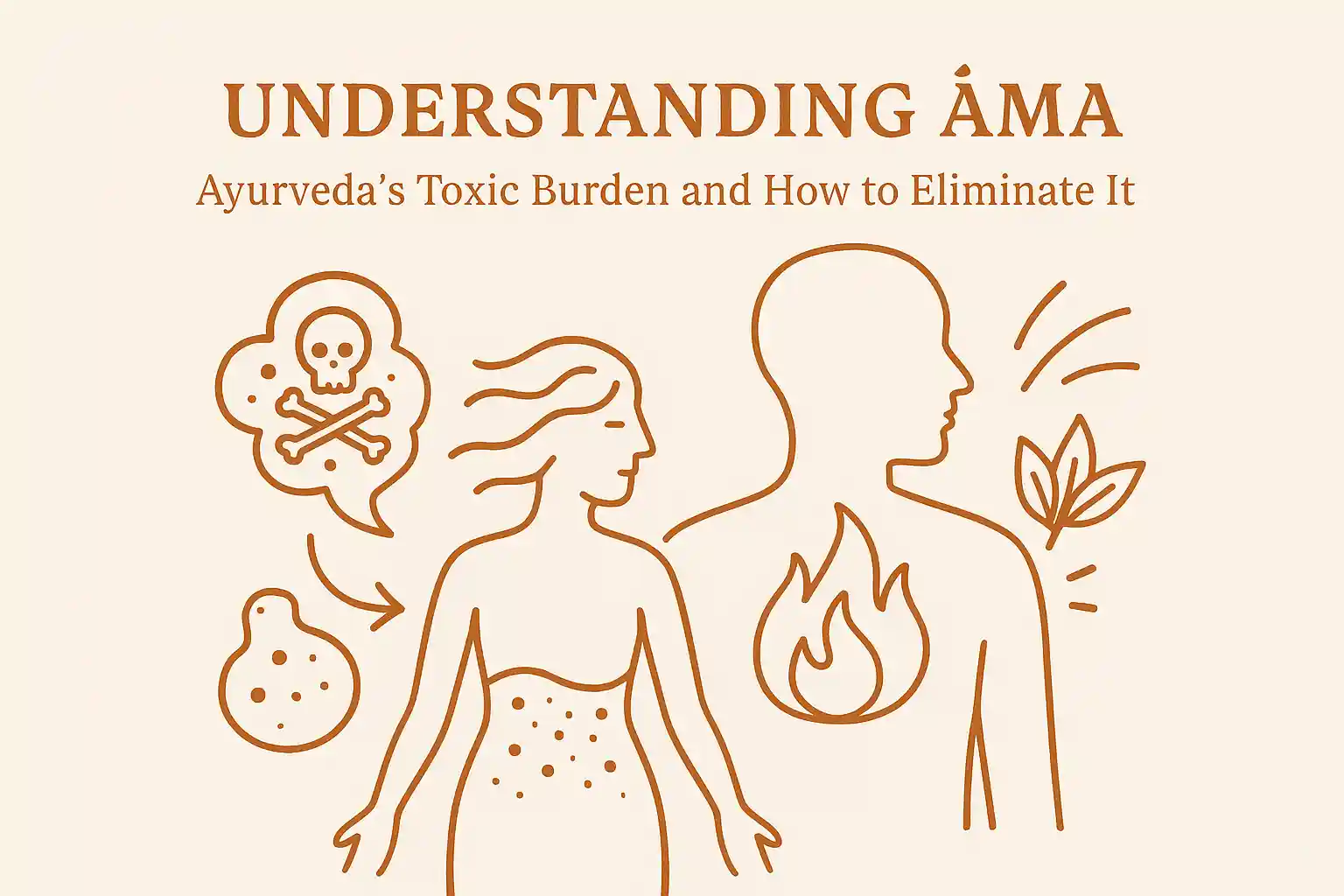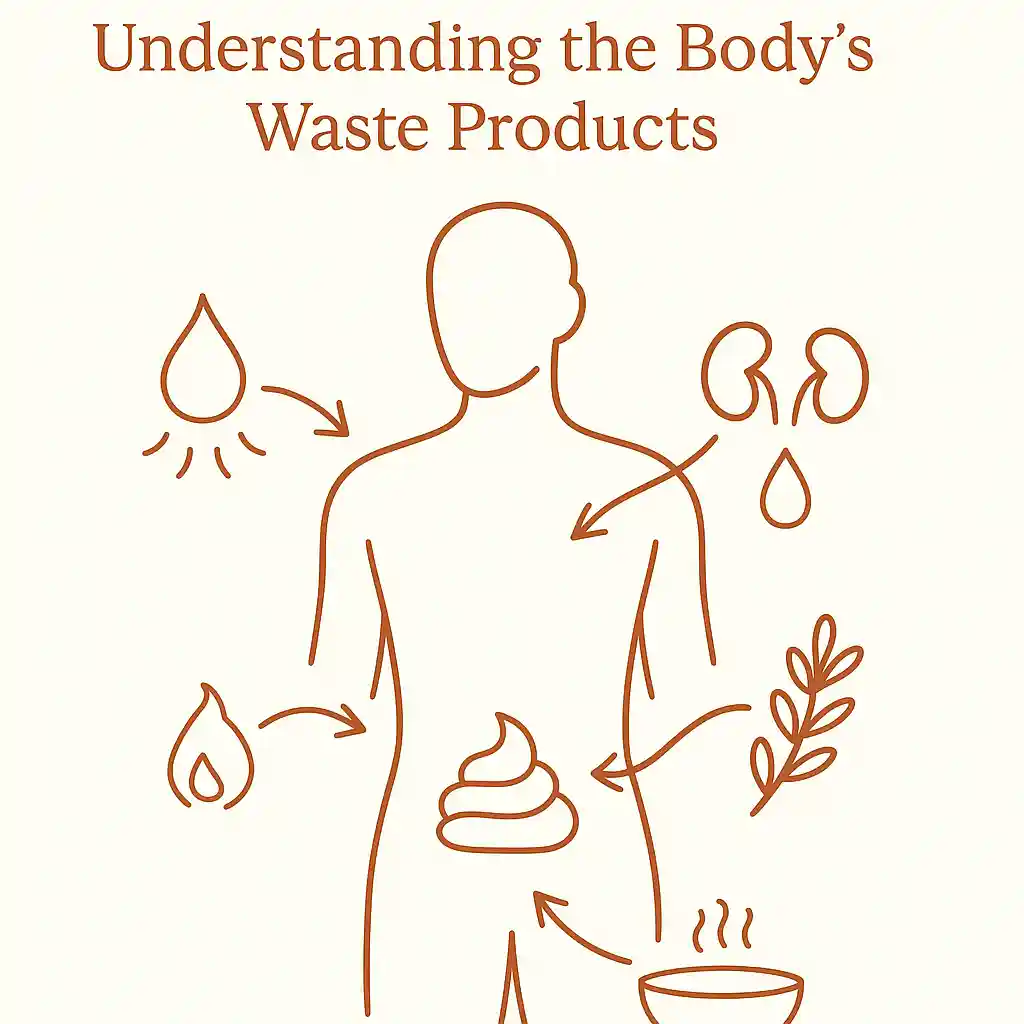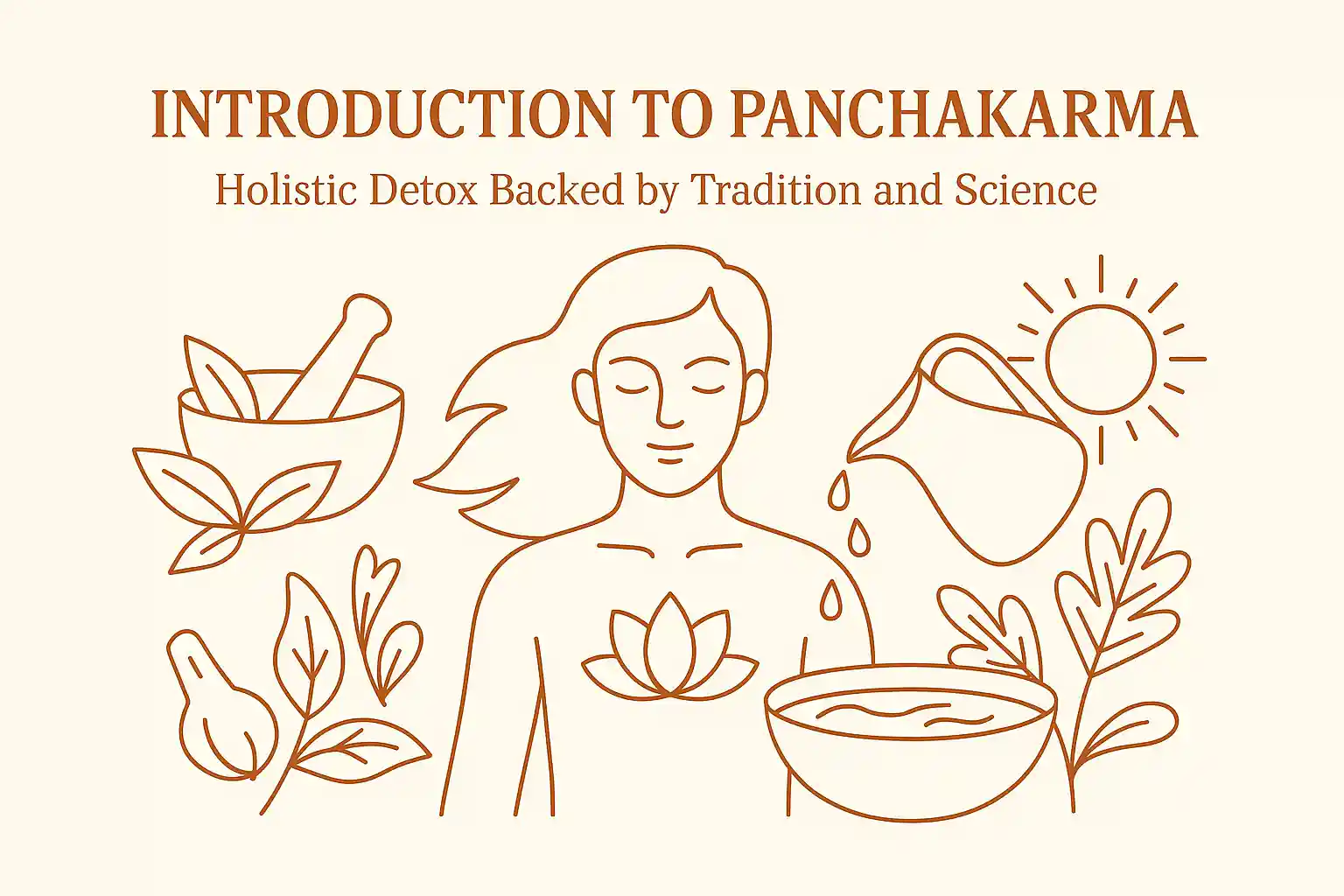Panchakarma, meaning "five actions" in Sanskrit, is Ayurveda's most profound system of detoxification and rejuvenation. It is not a quick cleanse or short-term fix—it's a multi-phase therapeutic process designed to remove deep-seated toxins (ama), restore balance among the three doshas (Vata, Pitta, Kapha), and reignite the digestive fire (agni) that governs health at every level.
Traditionally administered under the supervision of a trained Ayurvedic physician, Panchakarma includes preparatory practices (Purvakarma), core cleansing techniques (Shodhana), and post-treatment rejuvenation (Paschatkarma). These therapies are tailored to your unique constitution and current imbalances, offering personalized healing at the root cause level.
Scientific Validation
A 2020 clinical trial published in Journal of Alternative and Complementary Medicine found that a 7-day Panchakarma-based Ayurvedic intervention led to significant reductions in inflammatory markers, including interleukin-6 and C-reactive protein (CRP). Other studies show improvements in stress, metabolic health, and even gene expression regulation following Panchakarma protocols. These findings demonstrate how traditional practices gain scientific validation.
Whether you're seeking relief from chronic symptoms, a reset for mind-body balance, or a preventative longevity tool, Panchakarma remains one of Ayurveda's most trusted and time-tested paths to healing.
What Is Panchakarma?
Panchakarma is a comprehensive, multi-stage Ayurvedic therapy that literally means "five actions" or "five treatments." These actions are five distinct therapeutic procedures used to cleanse the body of toxins and restore constitutional balance.
Unlike general wellness detoxes that focus on symptom relief, Panchakarma is rooted in classical Ayurvedic texts (Charaka Samhita, Ashtanga Hridayam) and aims to eliminate toxins from the deep tissues, strengthen the digestive fire (agni), and rebalance the doshas. It's considered a complete mind-body reset, affecting not just the physical body but also the energetic, emotional, and mental layers of health.
The Five Core Cleansing Procedures
- Vamana (therapeutic emesis)
- Virechana (purgation)
- Basti (medicated enema)
- Nasya (nasal therapy)
- Raktamokshana (bloodletting — rarely used today)
Each component is used selectively, based on the patient's constitution, current state of imbalance, and seasonal or environmental factors.
Rooted in Classical Ayurvedic Texts
Panchakarma is not a modern invention—it is deeply rooted in the foundational texts of Ayurveda, such as the Charaka Samhita and Ashtanga Hridayam, where it is described as the primary method for removing vitiated doshas and restoring harmony in both body and mind.
"When doshas have accumulated in great quantity and have entered into the deeper tissues, they should be expelled by purification (Shodhana). Only then can balance be truly restored."
The Ashtanga Hridayam, another classical authority, emphasizes:
"Just as a dirty cloth cannot be properly dyed, a body filled with ama and doshic imbalance cannot properly heal or rejuvenate. Shodhana must come before Rasayana."
These ancient guidelines form the clinical blueprint that modern Ayurvedic physicians continue to follow—reinforcing Panchakarma's legitimacy not only as a traditional therapy, but as a systematically codified medical protocol.
Understanding Ama: The Root Cause of Disease
At the core of Panchakarma's effectiveness lies a central Ayurvedic concept: Ama—the undigested, toxic residue believed to be the root cause of most health issues. While Panchakarma involves various methods of cleansing, its deeper purpose is the elimination of Ama from the body's tissues and channels.
What Is Ama in Ayurveda?
In classical Ayurvedic medicine, Ama is considered the root cause of most diseases. It is a toxic, sticky residue that forms when digestion is weak or incomplete. Described in texts like the Charaka Samhita, Ama is said to be cold, heavy, cloudy, and obstructive—clogging the body's srotas (subtle channels) and disrupting normal doshic balance.
When left unaddressed, Ama mixes with the doshas (Vata, Pitta, Kapha), leading to compounded imbalances and deeper physiological dysfunction:
- Vata-Ama can cause joint pain, dryness, and constipation
- Pitta-Ama manifests as inflammation, acidity, and skin disorders
- Kapha-Ama leads to mucus buildup, congestion, and lethargy
Ama and Modern Physiology: A Biomedical Parallel
While the term "Ama" is unique to Ayurveda, its characteristics align with modern concepts of metabolic waste and systemic inflammation:
- Disrupted gut microbiota and poor digestion allow endotoxins to pass into circulation
- Low-grade metabolic endotoxemia contributes to inflammation, immune dysregulation, and chronic disease
- Ama's heaviness and stickiness parallel the biological effects of oxidative stress and cellular waste accumulation
Recent research supports this perspective: impaired gut health, poor elimination, and chronic stress are all linked to systemic toxicity and inflammation—an echo of what Ayurveda has identified for millennia.
The Three Phases of Panchakarma
Panchakarma unfolds in three distinct phases, each with a unique purpose in the detoxification and rejuvenation process. These stages are grounded in classical Ayurvedic texts and remain essential to achieving both therapeutic depth and safety.
1. Purvakarma (Preparation)
This preparatory phase is designed to mobilize toxins from deep tissues and bring them into the digestive tract, where they can be effectively eliminated. Techniques include:
- Snehan: Internal and external oleation with medicated oils or ghee
- Svedana: Herbal steam therapies to liquefy and move toxins
- Dietary Adjustments: Light, warm foods to kindle digestive fire (Agni)
Expert Insight
"Snehan prepares the tissues by ripening the toxins—Ama becomes ready to move. Without this step, detox may never reach the deeper tissues." - Dr. Vasant Lad
2. Shodhana (Main Cleansing Therapies)
This is the heart of Panchakarma—the five core cleansing procedures, selected based on your Dosha, symptoms, and condition:
| Therapy | Target Dosha | Purpose |
|---|---|---|
| Vamana (Emesis) | Kapha | Removes excess mucus and congestion |
| Virechana (Purgation) | Pitta | Clears heat and inflammation via the bowels |
| Basti (Enema) | Vata | Restores colon health and nervous system calm |
| Nasya (Nasal Therapy) | All doshas | Targets head and sinus toxins—especially for mental clarity |
| Raktamokshana (Bloodletting) | Pitta | Rare today, used for certain blood-related imbalances |
Each of these is applied selectively and under medical supervision. The goal is deep purification—not a general cleanse.
3. Paschatkarma (Post-Treatment Rejuvenation)
After detox, the body enters a vulnerable but transformative phase. This stage focuses on rebuilding strength, stability, and immunity:
- Rasayana Therapy: Herbal tonics and formulas for rejuvenation
- Reintroduction of Foods: Starting with soups and khichari, progressing slowly
- Lifestyle Support: Meditation, pranayama, and rest to stabilize results
This final step ensures long-term benefits and prevents reaccumulation of toxins. It's not just about feeling lighter—it's about cellular renewal.
Scientific Support for Panchakarma
Modern studies increasingly support the effectiveness of Panchakarma:
34% Reduction
in C-reactive protein (inflammation marker) after 7-day Panchakarma program
28% Decrease
in reported anxiety levels following treatment
22% Improvement
in sleep quality and duration
These findings suggest that Panchakarma does more than offer subjective relief—it also produces measurable physiological changes aligned with improved systemic health.
Benefits of Panchakarma
Panchakarma offers both curative and preventative benefits. Its deep detoxification process is especially valuable for individuals experiencing chronic inflammation, stress, digestive disorders, fatigue, and toxin overload from modern lifestyles.
Proven Benefits Include:
- Improved digestion and metabolic function
- Better sleep quality and reduced stress
- Reduction in joint pain and stiffness
- Lower systemic inflammation (e.g., CRP reduction)
- Enhanced mental clarity and mood stability
- Strengthened immune response
Long-term Perspective
In an observational study at the Kripalu Center, participants showed no immediate quality-of-life improvement following a 5-day Panchakarma retreat—but did report significant reductions in anxiety and increases in social support at 3 months post-treatment.
Is Panchakarma Right for You?
Panchakarma is not one-size-fits-all. It's a personalized therapy best suited to individuals prepared to follow dietary and lifestyle guidance, and willing to rest during the process.
✅ Ideal Candidates
- Individuals with chronic fatigue, digestive issues, or inflammation
- Those with stress, insomnia, or mental burnout
- People preparing for seasonal transitions or life changes
- Anyone seeking a deep physical, emotional, and energetic reset
⚠️ Contraindications
- Pregnant or nursing women
- Children under 12 or elderly without supervision
- Individuals with severe anemia, heart disease, or active infections
- People undergoing chemotherapy or immunosuppressive therapies
Important Note
Always consult an experienced Ayurvedic practitioner before beginning. Panchakarma isn't a one-size-fits-all weekend retreat—it's a therapeutic immersion that requires time, preparation, and commitment.
Cost and Duration
Panchakarma programs typically last 7, 14, or 21 days, depending on your health condition, dosha imbalance, and practitioner recommendation.
In India
More accessible and affordable, with packages ranging from $300 to $1,000 USD for a full program in reputable Ayurvedic clinics. These usually include:
- Daily treatments (Abhyanga, Basti, Nasya, etc.)
- Herbal medications
- Personalized meals and accommodation
- Doctor consultations and diagnostic pulse assessments
In the West
Ayurvedic centers and wellness resorts offer Panchakarma-based protocols priced between $2,000 and $8,000 USD, depending on:
- Length of stay and number of therapies
- On-site accommodation and amenities
- Level of personalization and medical oversight
Modified Options
Some clinics also offer modified or outpatient Panchakarma ("Panchakarma-lite") for those who can't take extended time off. These options may include:
- 1–2 daily treatments over a week
- Home-prepared dietary guidelines
- Virtual consultations with Ayurvedic doctors
How to Prepare for Panchakarma
7 Days Before:
- Begin eating lighter meals: warm, cooked foods, no processed items
- Reduce caffeine, alcohol, and sugar
- Sleep early and hydrate well
During Panchakarma:
- Follow your practitioner's advice on diet and rest
- Avoid work, stress, digital distractions
- Honor emotional release if it arises
After Panchakarma (Paschatkarma):
- Reintroduce foods gradually
- Practice gentle yoga, pranayama, and meditation
- Continue with herbal support or Rasayana (rejuvenation)
Recovery Protocol
Recovery is as important as the cleanse itself. These seven days help your body stabilize, integrate benefits, and prevent re-toxification.
Post-Treatment Integration
Days 1–2: Reset & Rebuild
- Stick to warm, soupy meals (like khichari, broths, herbal teas)
- Prioritize complete rest—your body is still detoxing
- Take short, slow walks to encourage circulation without strain
- Avoid digital stimulation and intense conversations
Days 3–4: Gentle Nourishment
- Begin your Rasayana protocol (rejuvenative herbs prescribed by your practitioner)
- Slowly reintroduce soft grains and cooked vegetables
- Spend time in nature or sunlight if possible
- Journal or reflect on emotional releases from the cleanse
Days 5–6: Light Movement Returns
- Introduce mild yoga, stretching, or tai chi
- Eat slightly more complex meals, avoiding raw or heavy foods
- Practice daily meditation and pranayama to calm the nervous system
- Schedule follow-up with your Ayurvedic provider if needed
Day 7: Reentry with Awareness
- Resume your regular (but balanced) diet—no processed foods yet
- Continue Rasayana and lifestyle routines for at least 1–2 weeks
- Reflect on internal changes: mood, energy, digestion, clarity
- Set intentions for maintaining Ayurvedic rhythms seasonally
Frequently Asked Questions
Ready to explore Panchakarma?
Discover Your Dosha
Understanding your constitution is the first step toward personalized Panchakarma
TAKE QUIZCheck Your Current Health
Analyze your symptoms and current state for Ayurvedic insights
ANALYZE SYMPTOMSRelated Articles

Understanding Ama: Ayurveda's Toxic Burden and How to Eliminate It
Discover Ama, the root cause of disease in Ayurveda. Learn how this toxic burden forms from weak digestion and explore safe, natural methods to eliminate it through dietary changes and detoxification practices.
9 min read
Mala in Ayurveda: Understanding the Body's Waste Products
Discover the three Malas—natural waste products that reflect your health in Ayurveda. Learn how proper elimination of Purisha, Mutra, and Sveda supports balance and prevents disease.
8 min read
